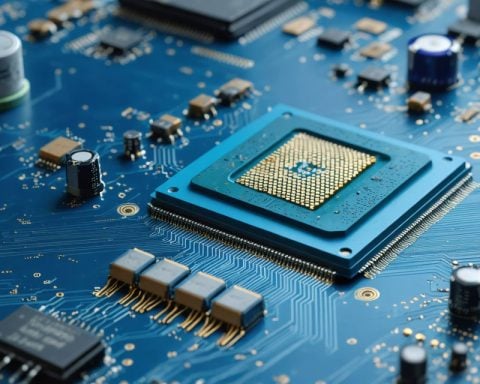Nvidia, a leading chipmaker, recently announced its fiscal second-quarter earnings, showcasing remarkable growth that exceeded analysts’ expectations. However, despite the impressive performance, the company’s stock experienced a decline, leaving investors concerned about the future.
In the second quarter, Nvidia’s sales skyrocketed by 122% year over year, reaching a total of $30 billion. Adjusted earnings per share (EPS) also saw significant growth, increasing by 152%. Although this growth rate was slightly slower compared to the previous quarter, it is still considered exceptional. The company’s data center business was the main driving force behind this success, with revenue surging by 154% to $26.2 billion. Nvidia attributed this growth to its Hopper graphics processing unit (GPU) computing platform, and the introduction of its newest H200 Hopper chip.
Despite scaling up production of its new Blackwell chips, Nvidia experienced a sequential decline in gross margins, which stood at a robust 75.1%. Although slightly lower than the previous quarter, this margin remains impressive. The company also generated a substantial amount of cash, with operating cash flow reaching $14.5 billion and free cash flow at $13.5 billion. Nvidia ended the quarter with net cash and marketable securities of $26.3 billion and announced a $50 billion share repurchase program.
Looking ahead, Nvidia forecasts a strong revenue of $32.5 billion for the third quarter. The company anticipates that the demand for its Hopper and Blackwell chips will continue to be robust, supported by the transition to its next-generation architecture. Nvidia expects Blackwell production to ramp up in the fourth quarter, further boosting revenue. It also predicts continued growth in its data center business, particularly due to the increasing need for computing power in next-generation large language models.
Despite these positive factors, investors remain cautious. Nvidia currently trades at a relatively modest valuation, with a forward price-to-earnings ratio (P/E) of just 30 times next year’s analyst estimates. While the demand for AI infrastructure is driving Nvidia’s growth, there is ongoing speculation about whether the investments being made by companies will yield significant results for software companies and their customers. If software companies do not witness substantial growth in the near future, it could potentially impact Nvidia’s valuation.
In conclusion, Nvidia’s exceptional growth and financial achievements make it an attractive investment option. However, investors should closely monitor the performance of software companies and their ability to capitalize on AI investments. As long as software company growth ramps up, Nvidia is likely to continue its upward trajectory in the market.
Additional facts:
– Nvidia’s gaming segment also performed well in the second quarter, with revenue increasing by 85% to $3.06 billion. The company credits this growth to a strong demand for its GeForce RTX graphics cards among gamers and content creators.
– The automotive segment, however, experienced a decline in revenue by 1% to $152 million. This decrease was attributed to the global chip shortage and supply chain challenges faced by the automotive industry.
– Nvidia has been expanding its presence in the artificial intelligence (AI) market, with its GPUs being widely used in data centers for machine learning and deep learning applications.
– In recent years, Nvidia has also focused on diversifying its product offerings beyond GPUs. It acquired Mellanox Technologies, a leading supplier of networking products, to strengthen its data center business and accelerate its growth in the high-performance computing market.
Key questions and answers:
1. What was the main driver behind Nvidia’s successful second-quarter growth?
Answer: Nvidia’s data center business, with revenue surging by 154% to $26.2 billion, was the main driving force behind the company’s growth. This success was attributed to the Hopper GPU computing platform and the introduction of the newest H200 Hopper chip.
2. What challenges did Nvidia face in the second quarter?
Answer: Nvidia faced a sequential decline in gross margins despite scaling up production of its new Blackwell chips. However, the gross margin of 75.1% remains impressive. The automotive segment also experienced a decline in revenue due to the global chip shortage and supply chain challenges.
Key challenges or controversies:
– One key challenge for Nvidia is the ongoing speculation about whether the investments being made by companies in AI infrastructure will yield significant results for software companies and their customers. If software companies do not witness substantial growth in the near future, it could potentially impact Nvidia’s valuation.
– The global chip shortage and supply chain challenges have also posed a challenge for Nvidia’s automotive segment.
Advantages and disadvantages:
Advantages:
– Nvidia has shown remarkable growth and financial performance, making it an attractive investment option.
– The company’s data center business and gaming segment have experienced strong revenue growth.
Disadvantages:
– The declining gross margins and challenges in the automotive segment highlight the potential risks and uncertainties faced by Nvidia.
– There is speculation about the long-term growth potential of software companies, which could impact Nvidia’s valuation.
Suggested related links:
– Nvidia News
– About Nvidia
– Nvidia Data Center



















